- Home
- Thomas Keneally
Bettany's Book
Bettany's Book Read online
Born in NSW in 1935, Thomas Keneally began his highly successful writing career in 1964. He won the Booker Prize in 1982 with Schindler’s Ark, which was made into the Academy Award winning film Schindler’s List by Stephen Spielberg. He is the author of six works of non-fiction, including The Great Shame, a story of the Irish in the Old World and the New, and has written twenty-four works of fiction which include The Chant of Jimmy Blacksmith, Gossip from the Forest and Confederates, each of which was shortlisted for the Booker Prize.
By the same author
Fiction
The Place at Whitton
The Fear
Bring Larks and Heroes
Three Cheers for the Paraclete
The Survivor
A Dutiful Daughter
The Chant of Jimmie Blacksmith
Blood Red, Sister Rose
Gossip from the Forest
Season in Purgatory
A Victim of the Aurora
Passenger
Confederates
The Cut-rate Kingdom
Schindler’s Ark
A Family Madness
The Playmaker
Towards Asmara
By the Line
Flying Hero Class
Woman of the Inner Sea
Jacko
A River Town
Non-fiction
Outback
The Place Where Souls Are Born
Now and in Time to Be: Ireland and the Irish
Memoirs from a Young Republic
Homebush Boy: A Memoir
The Great Shame
For Children
Ned Kelly and the City of Bees
All rights reserved. No part of this book may be reproduced or transmitted by any person or entity, including internet search engines or retailers, in any form or by any means, electronic or mechanical, including printing, photocopying (except under the statutory exceptions provisions of the Australian Copyright Act 1968), recording, scanning or by any information storage and retrieval system without the prior written permission of Random House Australia. Any unauthorised distribution or use of this text may be a direct infringement of the author’s and publisher’s rights and those responsible may be liable in law accordingly.
Bettany’s Book
ePub ISBN 9781742742687
Kindle ISBN 9781742742694
BETTANY’S BOOK
A DOUBLEDAY BOOK
First published in Australia and New Zealand in 2000 by Doubleday
This paperback edition first published in Australia and New Zealand in 2002
Copyright © The Serpentine Publishing Co. (Pty) Ltd, 2000
All rights reserved. No part of this publication may be reproduced, stored in a retrieval system, transmitted in any form or by any means, electronic, mechanical, photocopying, recording or otherwise, without the prior written permission of the publisher.
National Library of Australia.
Cataloguing-in-Publication Entry
Keneally, Thomas, 1935–.
Bettany’s book.
ISBN 978 1 86471 004 5 (pbk)
1. Sydney (N.S.W.) – Fiction. 2. Sudan – Fiction. I. Title.
A823. 3
Transworld Publishers
a division of Random House Australia Pty Ltd
Level 3, 100 Pacific Highway, North Sydney, NSW 2060
http://www.randomhouse.com.au
Random House New Zealand Limited
18 Poland Road, Glenfield, Auckland
Transworld Publishers
a division of The Random House Group Ltd
61–63 Uxbridge Road, Ealing, London W5 5SA
Random House Inc
1540 Broadway, New York, New York 10036
Cover painting by Garry Shead
CONTENTS
Cover
About the author
By the same author
Title Page
Copyright
Imprint Page
Dedication
Foreword
Part One
Part Two
Part Three
Epilogue
To Rory Coverdale, fresh to Australia and the world.
Foreword
Details of the pastoral life and wool-growing in nineteenth century Australia are taken from W.A. Brodribb’s Recollections of An Australian Squatter, 1883, and Stephen H. Roberts’s The Squatting Age in Australia, 1835–1847, 1935.
Many of the incidents of W.A. Brodribb’s life occur also to Jonathan Bettany, but for the sake of Brodribb’s memory it must be said that the intimate sins and failures attributed to Bettany in these pages are pure invention.
Similarly, I hasten to say that the incidents that take place at Sydney University and which involve academic turpitude are entirely fictional and are not based on any events I have ever heard of, nor are any of the characters based on Sydney University staff or students, past or present.
The quotations from Horace are taken from The Odes of Horace translated by James Michie, 1964, and Horace, Eduard Fraenkel, 1957. The English translations are my own work, though I did take my tone from the lyrical spirit of Michie’s own free-flowing translations.
Any quotations from the Islamic scriptures are taken from The Koran, translated by N.J. Dawood, 1956.
I am grateful to Abbas Elzein of Sydney, himself a fine writer, for advice and the correction of any Arabic phrases which appear here.
For information on the work of NGOs and their field officers, I owe a debt to James Inglis, Jill Jamison, Graham Romanis, Sandra Heeney and Simon Williamson, who have all had a devoted interest in the Sudan. My daughter Jane gave similar help on matters to do with the Australian film industry. Needless to say, any errors or excesses appearing in the text are my own.
I would be wrong to conclude without thanking Louise Thurtell and Amanda O’Connell of Sydney and Carole Welch of London, the midwives of this long and complex text, and as ever, my wife Judith, who is under the persistent impression I am a writer.
Thomas Keneally, Sydney 2000
The simultaneous loss of her parents when she was nineteen had not seemed to throw any shadow across Dimp Bettany’s bright eye. Even her more dutiful sister, Primrose, admitted how infrequently and with what a shock of strangeness she remembered the fact of the instant deaths of her parents. This end, which had come in a collision on one of the hundreds of kilometres of narrow stretches of the Pacific Highway, felt, when recollected, as if it meant less to her and Dimp than it decently should.
Perhaps that was because their parents had lived orderly lives and died in an exemplary way. Despite the head-on ferocity, there were very few visible injuries except for the fatal depressed fractures. Or it may have been because their mother had been ever distracted, fretful, remote; and their father, Gordon Bettany, as irresponsibly jovial as an uncle. Rather in the spirit of his life, he was said by the coroner to have died while sleeping in the passenger seat, and with an unregistered micro-second of massive concussion. Her life ending in that same micro-second, Angela Bettany, so the sisters were told and told each other, had suffered only a few seconds of apprehension, though that thought should have been pitiable enough to haunt them.
Dimp must think of them, Prim guessed, but it seemed an undue embarrassment to their tidy ghosts to ask her, and almost an affront to the joyous, rowdy woman Dimp had made of herself. Prim encountered them in dreams, but woke with more surprise than loss. While she was a student, Primrose would remind her dazzling sister in person or by phone each anniversary of the disaster, and there would be a pause in their talk, composed perhaps of two parts sadness and one part guilt.
‘Come on,’ Dimp said once, sniffing out her sister’s uneasiness. ‘You’d turned seventeen. Parents mean less to you when you�
�re that age than at any other time of your life.’
But from the occasional references to parents, separated by hundreds of days in which Mr and Mrs Bettany barely got a mention, Prim came to feel that, if she and Dimp were to be good daughters of the dead, instead of offering the normal annual currency of wistfulness, nostalgia and the occasional disbelieving sense of vacancy, they owed a daily burden of grief, and that the failure to be a good daughter made her something of an exile, and thus prone to be rushed to orphan foolishness and to reckless journeys. She was the daughter who desired a conscientious and well-ordered life.
The sisters, Dimple and Primrose, had inherited their parents’ bank account which was very nearly in overdraft. The family house in Turramurra, in which the sisters continued to live for four years under the supervision of neighbours who had thought well of their parents, had in the end to be sold. The sisters went to live in a grim little red-brick flat in Redfern. Dimp was by then twenty-three years old, just beginning her career. After settlement of their parents’ debt the girls were left with a margin of little more than $25 000 each and, conscientiously, Prim chose to invest hers in a fund for her education and future.
In the early 1980s, Dimp Bettany, universally regarded as an unself-consciously beautiful woman, of a darker and fuller handsomeness than her more abstractly appealing sister, found a job in the television documentary department of the Australian Broadcasting Corporation where she was soon liked by everyone. She was relieved to find that her name, as it appeared as assistant producer on credits, was interpreted by her colleagues as a shortening of Dymphna, instead of the reality – the achingly awful Dimple.
Dimp seemed to her more reserved sister Primrose – Prim by preference – to be above all a glowing, heedless orphan. Prim saw herself as an earnest undergraduate drudge with post-graduate ambitions, who required of herself a series of distinctions and credits in her sundry subjects – even an occasional high distinction. When she scored a high distinction in anthropology, she could picture her father saying, ‘A high distinction at Sydney University! Imagine!’
Men distantly admired Primrose. Dimp was desired. Abundantly alive, a frequent laugher, carrying her orphan status lightly, Dimp seemed imperishably lit with inner light. The accepted wisdom in the ABC documentary department was that no one – farmer, couturier, politician, mountaineer – refused to be the subject of a documentary if Dimp Bettany was sent to ask them. No one – male or female – was immune from Dimp’s famous good cheer, force of soul, looks and enthusiastic, sensual and childlike soul. It was the way, even when hungover, she looked fresh-minted. And her sumptuous features shone with an unconscious spirituality, the spirituality of wanting to make a film. She was avid for the nuances of character as revealed in the stories of strangers.
And she was of course an excellent greeter, counsellor to and assurer of the subjects of documentaries – ‘No, I don’t think you need to change your clothes … Of course we have to make sure there’s times for you to have a rest … No, I think the blue one’s more your colour.’ Even though she dressed carelessly herself.
One of the documentary subjects Dimp worked on – who was to change the course of her life – was an Italian by the name of Lorenzo Cortini. A graduate of the military academy in Modena and an officer in Mussolini’s armies in Libya, Lorenzo had been a prisoner-of-war in Australia during the Second World War. Meeting Dimp during an informal press conference when he revisited Australia on the verge of old age, this professional soldier had told her how appalled he had been when his platoon, and the battalion they were part of, and the division of which the battalion was part, showed very little resoluteness in defending Mussolini’s Libyan coastal fortress of Bardia from the Australians long before, in 1941. It was the Australian connection which fascinated Dimp.
After being shipped to Australia as a prisoner-of-war, Cortini, Dimp discovered, made three escape attempts. During each he found himself generously protected by southern Italian sultana-growers in the Riverina, along the Murray River. In meeting these immigrants, and depending on them for refuge, he was thrown together with Italians far below him in social stature, Siciliani e Calabresi, lower than the lowest non-swarthy member of the platoon and crack regiment that had let him down at Bardia, and less capable of speaking real Italian.
Some of those at whose firesides deep in the bush Lorenzo Cortini was protected were laconic socialists. They called him Enzo and mocked in raw dialect all the florid promises of a new Roman Empire which had crumbled so easily before Australia’s yokel soldiers at Bardia and Benghazi. On the run, Lorenzo Cortini was reduced to wearing the rough clothing of these people, eating their bowel-bruising cuisine, sleeping on their bare floorboards, and bearing the papers and harsh name of a deceased Calabrian peasant immigrant. The aristocrat from the military academy hid beneath the lumpy beds of farmers in a dead man’s suit, the sweat and dust of anonymous labour clinging to its seams. In this process Cortini became, as he told an engrossed Dimp, ‘democratised’.
‘On the last continent on earth, I discovered the size of the world.’
Going to Melbourne with his false alien papers, he lived in a boarding house in Coburg populated by metal workers and small-time salesmen, and fell in love with his landlady, a young, red-headed Australian widow named Maggie Slattery, a leftist within the ranks of the Australian Labor Party. Under her influence, Enzo volunteered to steal a union ballot box before the candidates his landlady favoured could be outvoted by a phalanx of right-wing Catholics. Waylaid on the way home, the ballot box in a basket on the front of his bicycle, the landlady’s sweet company ahead of him, he was beaten up with the weapons of the antipodean working class – a cricket bat and two stumps.
To Dimp’s delight, the tale of Lieutenant Lorenzo Cortini even possessed a relentless Inspector Javert figure, a fatherly federal policeman who hunted and ultimately recaptured him after his longer period at large.
The documentary Dimp helped make, and persuaded Enzo Cortini to participate in, related his return to Australia to visit the former high security prison in the country town of Hay, from which he had escaped. He had also come back to honour the Italian farmers of the Riverina who had hidden him, and to make a pilgrimage to Melbourne, where he had remained a year at large impersonating the deceased Calabrian. The crew Dimp worked with got excellent footage of both. With a palpating gesture of his right hand, Cortini called Melbourne ‘the city of my heart’.
During Enzo Cortini’s journeys over the route of his escape in the Australian bush, Dimp was his driver, adviser, companion, acting coach, manager, and confidante. Outside country motels in frosty Australian dawns, Lorenzo Cortini wore his overcoat over the shoulders, in a stylish Florentine manner, smoked a cigarette in that seemingly non-carcinogenic graceful way which characterised the heroes of film noir, and chattered away with his new Australian friend. What other intimacy or refuge Dimp gave Enzo on his Australian pilgrimage was a matter of speculation not only for the camera crew, but later, from the inconclusive account Dimp gave of it, for her more serious-minded sister, Prim.
Before Enzo returned to Italy, Dimp continued to spend time with him in Sydney, interviewing him in more depth and getting his experiences on tape. She had had since childhood a capacity to be consumed by stories, and this was now what she was inflamed by – the tale of the Fascist converted to a dream of fraternity by the great Australian rawness; the elegant Latin, under his fake, undistinguished name, selling little bottles of lotion house-to-house in wartime Melbourne to women wearied by loneliness. With his Italian cinema idol looks he was sometimes irresistibly drawn into the role of consoler of the Home Front.
Dimp had been persuaded by the family’s solicitor to invest her portion of the proceeds from the Turramurra sale. But before Cortini’s return to Italy (the documentary completed) Dimp withdrew the full amount to buy feature film rights to Cortini’s life from the man himself (‘I am, after all, Dimple cara, not a wealthy man!’), and to pay a screenwriter. She
thought she had discovered an essentially Australian odyssey, and Cortini was its antipodean voyager. She found a Melbourne director, Frank Varduzzi, child of Italian immigrants himself, with one good feature film of the childhood-confessional variety behind him. Varduzzi became enthused too – after all, his grandparents and parents had been interned at the start of the Second World War, and he came from exactly that background of poor Italian immigrants at whose hands Cortini received his Australian education.
Lorenzo Cortini died in his sleep in Florence, but the film funding came through from sundry sources. The Australian Film Development Corporation invested what was then considered a generous fifty per cent, Film Victoria supplied twenty-five per cent, the Italian–Australian Federation was persuaded to contribute money, as were a string of private investors under the tax concession scheme named 10B(a). The film was shot for a modest $1 300 000 in the Victorian Riverina, Melbourne, and in a studio in Sydney, and made the careers of many people – Varduzzi; Colin Maberley, who played Cortini for $40 000 and within a year and a half was earning two million per flick; the cameraman Ossie Bendall; Sharon Bribie as the boarding house keeper. The film was entitled Enzo Kangaroo, was selected for showing in Directors’ Week in Cannes, was snapped up too cheaply by an American distributor, and, according to the pattern by which distributors make the most money out of such films, made Dimp famous but returned little. But renowned, and much photographed, she had become a culture hero in a community which yearned for such figures.
Her film and perhaps a half dozen others rang in an enthusiastic era when accountants advised entrepreneurs to invest in films for their tax breaks. Lacking a project which called to her as fiercely as the Enzo story had, Dimp, who had acquired financial expertise at the cash-starved ABC, had in fact done the budget for Enzo Kangaroo, was invited to speak for excellent fees at symposia for business investors. She also developed expertise in doing spreadsheet budgets for films, good and bad, generated by this investment. For despite the success of Enzo Kangaroo, she did not consider herself genuinely creative. Nor did she make it known that she received somewhat more predictable an income for doing these film-related tasks than she had as a producer. Her sister knew it, and other things, and was proud of her.

 Confederates
Confederates Flying Hero Class
Flying Hero Class Gossip From the Forest
Gossip From the Forest Schindler's List
Schindler's List Bring Larks and Heroes
Bring Larks and Heroes Australians: Flappers to Vietnam
Australians: Flappers to Vietnam The People's Train
The People's Train Crimes of the Father
Crimes of the Father A Family Madness
A Family Madness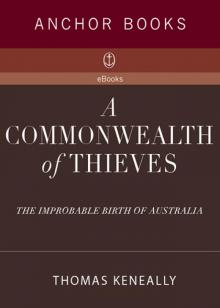 A Commonwealth of Thieves
A Commonwealth of Thieves Ned Kelly and the City of Bees
Ned Kelly and the City of Bees A River Town
A River Town Bettany's Book
Bettany's Book Blood Red, Sister Rose: A Novel of the Maid of Orleans
Blood Red, Sister Rose: A Novel of the Maid of Orleans Victim of the Aurora
Victim of the Aurora American Scoundrel American Scoundrel American Scoundrel
American Scoundrel American Scoundrel American Scoundrel Three Cheers for the Paraclete
Three Cheers for the Paraclete Australians: Origins to Eureka: 1
Australians: Origins to Eureka: 1 The Power Game
The Power Game The Chant Of Jimmie Blacksmith
The Chant Of Jimmie Blacksmith The Daughters of Mars
The Daughters of Mars Searching for Schindler
Searching for Schindler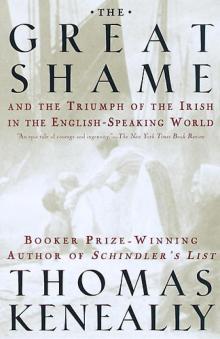 The Great Shame: And the Triumph of the Irish in the English-Speaking World
The Great Shame: And the Triumph of the Irish in the English-Speaking World Abraham Lincoln
Abraham Lincoln The Widow and Her Hero
The Widow and Her Hero Eureka to the Diggers
Eureka to the Diggers Shame and the Captives
Shame and the Captives The Survivor
The Survivor Jacko: The Great Intruder
Jacko: The Great Intruder The Book of Science and Antiquities
The Book of Science and Antiquities Homebush Boy
Homebush Boy The Playmaker
The Playmaker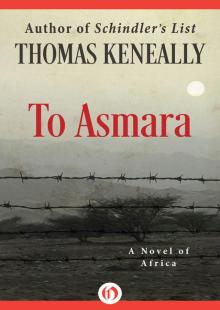 To Asmara: A Novel of Africa
To Asmara: A Novel of Africa A Woman of the Inner Sea
A Woman of the Inner Sea The Tyrant's Novel
The Tyrant's Novel Australians
Australians Schindler's Ark
Schindler's Ark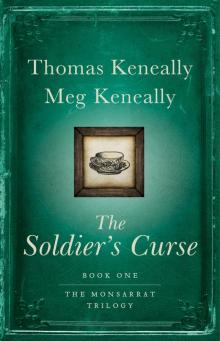 The Soldier's Curse
The Soldier's Curse Australians, Volume 3
Australians, Volume 3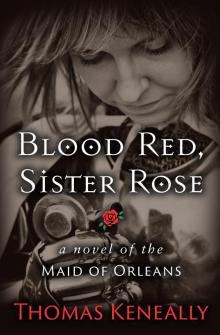 Blood Red, Sister Rose
Blood Red, Sister Rose A Victim of the Aurora
A Victim of the Aurora The Unmourned
The Unmourned Australians, Volume 2
Australians, Volume 2 To Asmara
To Asmara